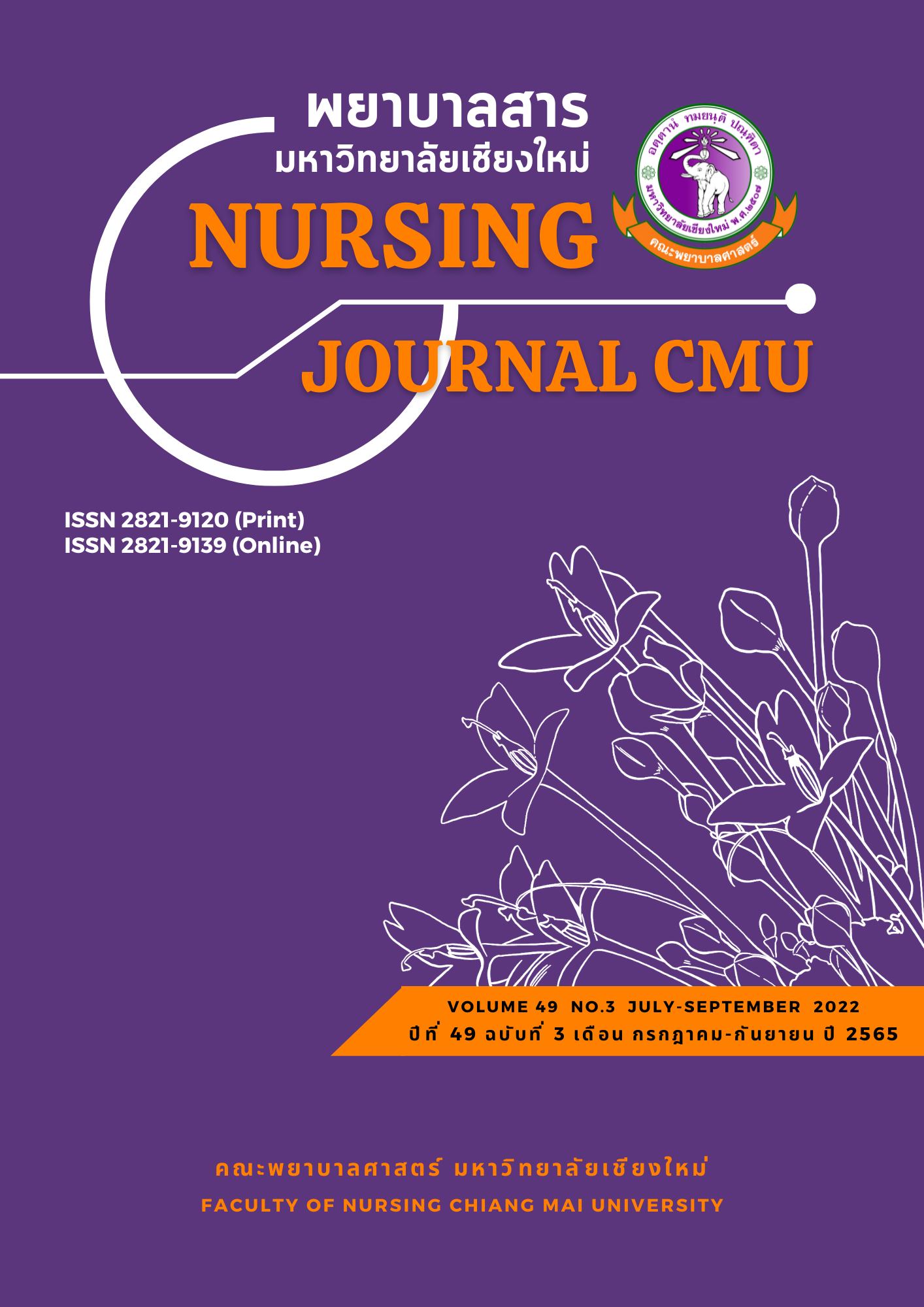ทัศนคติการเป็นมารดา ความอ่อนล้า และความสามารถในการปฏิบัติหน้าที่ของมารดาวัยรุ่น
คำสำคัญ:
ทัศนคติการเป็นมารดา, ความอ่อนล้า, ความสามารถในการปฏิบัติหน้าที่, มารดาวัยรุ่นบทคัดย่อ
การเป็นมารดาวัยรุ่นถือเป็นเหตุการณ์สำคัญในชีวิต ภายหลังคลอดมารดาวัยรุ่นต้องเผชิญกับการเปลี่ยนแปลงทั้งด้านร่างกาย และจิตใจ ที่อาจส่งผลกระทบต่อความสามารถในการปฏิบัติหน้าที่ของมารดาวัยรุ่น การวิจัยเชิงพรรณนาแบบหาความสัมพันธ์ครั้งนี้ มีวัตถุประสงค์เพื่อศึกษาความสัมพันธ์ระหว่างทัศนคติการเป็นมารดา ความอ่อนล้า และความสามารถในการปฏิบัติหน้าที่ของมารดาวัยรุ่น กลุ่มตัวอย่างคัดเลือกแบบเจาะจงตามคุณสมบัติที่กำหนด เป็นมารดาวัยรุ่นอายุ 13-19 ปี ที่มาใช้บริการตรวจหลังคลอด ที่โรงพยาบาลมหาราชนครเชียงใหม่ โรงพยาบาลส่งเสริมสุขภาพ ศูนย์อนามัยที่ 1 เชียงใหม่ และโรงพยาบาลลำพูน จำนวน 85 ราย เครื่องมือที่ใช้ในการวิจัยคือ แบบประเมินทัศนคติการเป็นมารดาของ ซอกกอล, แอพเปอร์สัน, และ บาร์เบอร์ (Sockol, Epperson & Barber, 2014) ฉบับภาษาไทยโดย อักษราณัฐ ภักดีสมัย, พรรณพิไล ศรีอาภรณ์, และ ปิยะนุช ชูโต (Pukdeesamai, Sriarporn, & Xuto, 2015) แบบประเมินความอ่อนล้าของ พิวจ์, มิลลิแกน, พาร์ค, เลนส์, และ คิทซ์แมน (Pugh, Milligan, Park, Lenze, & Kitzman, 1999) ฉบับภาษาไทยโดย จรัสศรี ธีระกุลชัย (Theerakulchai, 2004) และแบบประเมินความสามารถในการปฏิบัติหน้าที่ของมารดาวัยรุ่นของ ลอกส์ดอน (Logsdon, 2009) ดัดแปลงโดย วรัญญา มูลธิโต, พรรณพิไล ศรีอาภรณ์, และ ฉวี เบาทรวง (Moortito, Sriarporn, & Baosoung, 2015) วิเคราะห์ข้อมูลโดยใช้สถิติพรรณนา และสถิติ Pearson's product moment correlation
ผลการวิจัยพบว่า
- มาดาวัยรุ่นส่วนใหญ่มีทัศนคติการเป็นมารดาในทางลบร้อยละ 67.06 (SD = 9.81) พบความอ่อนล้าในระดับต่ำคิดเป็นร้อยละ 78.82 (SD = 16.66) และความสามารถในการปฏิบัติหน้าที่พบว่า มีค่าคะแนนของความสามารถในการปฏิบัติหน้าที่ของมารดาวัยรุ่นโดยรวมอยู่ในระดับปานกลาง (SD = .25)
- ความอ่อนล้ามีความสัมพันธ์ทางลบระดับต่ำกับความสามารถในการปฏิบัติหน้าที่ของมารดาวัยรุ่นอย่างมีนัยสำคัญทางสถิติ (r = -.214, p < .05) และทัศนคติการเป็นมารดาไม่มีความสัมพันธ์กับความสามารถในการปฏิบัติหน้าที่ของมารดาวัยรุ่น
ผลการวิจัยครั้งนี้ สามารถใช้เป็นข้อมูลพื้นฐานสำหรับการวางแผนการพยาบาลที่มีประสิทธิภาพในการส่งเสริมความสามารถในการปฏิบัติหน้าที่ในระยะหลังคลอดของมารดาวัยรุ่น
เอกสารอ้างอิง
Birkeland, R., Thompson, J. K., & Phares, V. (2005). Adolescent motherhood and postpartum depression. Journal of Clinical Child and Adolescent Psychology, 34, 292-300.
Crugnola, C. R., Ierardi, E., Gazzotti, S., & Albizzati, A. (2014). Motherhood in adolescent mothers: Maternal attachment, mother-infant styles of interaction and emotion regulation at three months. Infant Behavior & Development, 37, 44-56.
Cunningham, F. G., Leveno, K. J., Bloom, S. L., Spong, C. Y., Dashe J. S., Hoffman, B. L., Sheffield, J. S. (2014). Williams Obstretrics (24th ed.). New York: McGraw Hill.
Davidson, M. R., London, M. L., & Ladewig, P. W. (2012). Olds' maternal-newborn nursing & women's health across the lifespan. Boston: Pearson.
DeVito, J. (2010). How adolescent mothers fell about becoming a parent. The Journal of Perinatal Education, 19(2), 25-34.
Fawcett, J., & Tulman, L., (1990). Functional status during pregnancy and the postpartum: A framework for research. Journal of Nursing Scholarship, 23, 191-194.
Fawcett, J., Tulman, L., & Myers, S.T. (1988). Development of the inventory of functional status after childbirth. Journal of Nurse Midwifery, 33, 252–260.
Figueiredo, B., Tendais, I., Dias, C. C. (2014). Maternal adjustment and maternal attitudes in adolescent and adult pregnant women. Journal of Pediatric and Adolescent Gynecology, 27(4), 194-201.
Gardner, D.L. (1991). Fatigue in postpartum women. Applied Nursing Research, 4(2), 57-62.
Logsdon, M. C. (2009). Initial psychometric properties of the inventory of functional status after childbirth-revised for adolescents. Journal of Reproductive and Infant Psychology, 27(4). 346-356.
MacDonald, I. B. (2011). Physical activity and postpartum functional status in primiparous women. Retrieved from http://www.qspace.library.queensu.ca/bitstream/1974/6812/1/Barbacsy- MacDonald_Ibo_201109_MSc.pdf
McVeigh, C. (1997). An Australian study of functional status after childbirth. Midwifery, 13, 172-178.
Moortito, W., Sriarporn. P., & Baosoung, C., (2015). Postpartum depression, social support, and functional status among adolescent mothers. Nursing Journal, 44(2), 19-29. (in Thai)
Office of the Permanent Secretary, Ministry of Social Development and Human Security. (2013). The situation of childbirth among Thai adolescents in 2013. Nonthaburi: Ministry of Interior. (in Thai)
Polit, D. F. (2010). Statistics and data analysis for nursing research (2nd ed.). New Jersey: Pearson Education.
Posmontier, B. (2008). Functional status outcomes in mothers with and without postpartumdepression. Journal Midwifery Women Health, 53(4), 310-318.
Pukdeesamai, A., Sriarporn, P., & Xuto, P. (2015). Factors predicting postpartum depression among first-time mothers. Nursing Journal, 44(3), 19-29. (in Thai)
Pugh, L. C., & Milligan, R. (1993). A framework for study of childbearing fatigue. Advanced Nursing Science, 15(4), 60-70.
Pugh, L. C., Milligan, R., Parks, P. L., Lenz, E. R., & Kitzman, F. H. (1999). Clinical approaches in the assessment of childbearing fatigue. Journal of Obstetrics, Gynecologic, and Neonatal Nursing, 28, 74-80.
Rychnovsky, J. (2007). Postpartum fatigue in the active-duty military woman. Journal of Obstetric, Gynecologic, and Neonatal Nursing, 36(1), 38-46.
Secco, M. L., & Moffat, M. E. K. (2003). Situational maternal and infant influences on parenting stress among adolescent mother. Comprehensive Pediatric Nursing, 26(2), 103-122.
Shereshefsky, P. M., & Yarrow, L. J. (1973). Psychological aspects of a first pregnancy and early postnatal adaptation. New York: Raven Press.
Shin, H. & White, R. (2007). The conceptual of transition to motherhood in neonatal intensive care unit. Journal of Advance Nursing, 58(1), 90 – 98.
Sockol, L. E., Epperson, C. N., & Barber, J.P. (2014). The relationship between maternal attitudes and symptoms of depression and anxiety among pregnant and postpartum first-time mothers. Archives of Women's Mental Health,17, 199-212.
Theerakulchai, J., 2004. Factors related to fatigue and fatigue management in postpartum Thai women. Journal of Nursing and Health Research, 8(3), 23-34. (in Thai)
Tulman, L., & Fawcett, J. (1988). Return of functional ability after childbirth. Nursing Research, 37(2), 77-81.
Tulman, L., Fawcett, J., Groblewski, L., & Silverman, L. (1990). Changes in functional status after childbirth. Nursing Research, 39(2), 70-75.
Wahn, E. H., Nissen, E., & Ahlberg, B. M. (2005). Becoming and being a teenage mother. Health Care for Women International, 26(7), 591-603.
Walker, L.O., Crain, H., & Thompson, E. (1986). Maternal role attainment and identity in the postpartum period: Stability and change. Nursing Research, 35, 68-71.
World Health Organization. (2014). Adolescent pregnancy. Retrieved from http://www.who.int/mediacentre/factsheets/fs364/en/
ดาวน์โหลด
เผยแพร่แล้ว
รูปแบบการอ้างอิง
ฉบับ
ประเภทบทความ
สัญญาอนุญาต

อนุญาตภายใต้เงื่อนไข Creative Commons Attribution-NonCommercial-NoDerivatives 4.0 International License.
บทความที่ได้รับการตีพิมพ์เป็นลิขสิทธิ์ของวารสารพยาบาลสาร
ข้อความที่ปรากฏในบทความแต่ละเรื่องในวารสารวิชาการเล่มนี้เป็นความคิดเห็นส่วนตัวของผู้เขียนแต่ละท่านไม่เกี่ยวข้องกับมหาวิทยาลัยเชียงใหม่ และคณาจารย์ท่านอื่นๆในมหาวิทยาลัยฯ แต่อย่างใด ความรับผิดชอบองค์ประกอบทั้งหมดของบทความแต่ละเรื่องเป็นของผู้เขียนแต่ละท่าน หากมีความผิดพลาดใด ๆ ผู้เขียนแต่ละท่านจะรับผิดชอบบทความของตนเองแต่ผู้เดียว






